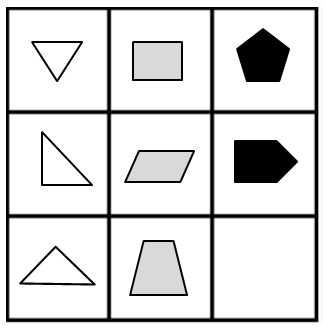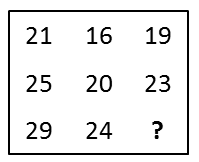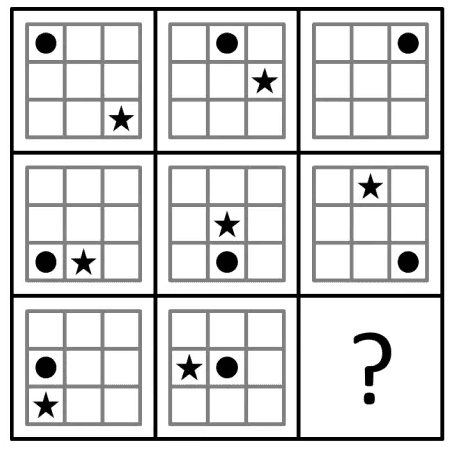Want to know what to expect on the OLSAT?
The best way to prepare is by using sample questions that reflect the real test format. On this page, you'll find free OLSAT practice questions designed to show the types of questions students are likely to see on test day. These examples help build familiarity, reduce anxiety, and improve performance.
Prepare for the OLSAT Test with Practice Questions
Get a sneak peek at the types of questions your child will encounter on the Otis-Lennon School Ability Test (OLSAT). We'll explore the different types of questions together, including:
- Verbal questions that test your child's understanding of language and comprehension skills
- Non-verbal questions that assess problem-solving and spatial reasoning abilities
- Quantitative Reasoning questions that require logical thinking and the ability to recognize and apply numerical patterns and relationships. Are found on Levels D, E,F and G
All of these questions are designed to be relevant to your child's current grade level, so you can feel more confident and prepared as they take the test. Levels A, B and C are read to the test-taker as this test is not a measure of reading.
Choose Your OLSAT PrepPack!
Understanding each OLSAT level is crucial for proper test preparation. Let's explore sample questions from each level to give you a clear picture of what to expect.
OLSAT Sample Questions Level A
These questions test a child's ability to listen and follow instructions. The instructor reads directions aloud, and the student must choose the correct answer based on those directions.
TestPrep-Online Tutor's Tip:
Practice Tip: I like to mix up toys or flashcards (like a spaceship, alien, and astronaut) and ask my child to line them up in the correct order as I describe. This hands-on activity builds sequencing confidence and makes abstract directions feel more concrete and fun!
OLSAT Picture Analogies: These use images instead of words and students must recognize relationships between pairs of pictures.
By using pictures instead of words. Students must identify which image doesn't belong with the rest
Moving up to the next level of difficulty, OLSAT Sample Questions Level B introduces new concepts...
OLSAT Sample Questions Level B
Arithmetic Reasoning- These questions involve solving math problems presented in word format and the word problems are read aloud.
TestPrep-Online Tutor's Tip:
My main goal is building confidence and process understanding. I always start by reading the problem aloud with the child, ensuring they process the words. Then, we break it into smaller chunks with guiding questions: "How many did they start with?", "How many did Jayden eat?", "How many eaten altogether?". I encourage visualizing or drawing (e.g., drawing lollipops and crossing them out). We also emphasize keywords like "total" (addition) and "gone" (subtraction). Finally, I celebrate their effort and understanding, even with mistakes, to foster problem-solving skills and future confidence.
Picture Classification: Requires identifying the image that doesn't belong in a set
As students progress to OLSAT Sample Questions Level C, they encounter more complex questions that build upon previous skills.
OLSAT Sample Questions Level C
Aural Reasoning:This type of question assesses a student's ability to listen to, understand, and visualize information presented verbally
TestPrep-Online Tutor's Tip:
"When I help kids with questions like this, I always say, 'Let’s break it down like a detective!' First, we underline or say out loud exactly what we're looking for — in this case, a small triangle pointing up, a big triangle pointing down, and a star to the left of a circle. Then, I show them how to scan each picture slowly, one at a time, checking for each piece of the clue — just like checking off items on a treasure map. I remind them it’s okay to eliminate wrong ones — crossing them out builds confidence. The key is not to rush and to trust their eyes and brain to work together. With practice, they’ll feel more sure of their answers!"
Start Your OLSAT Practice Today
Build confidence through hands-on experience with real OLSAT-style questions. Try it now
Figural Classification questions test your ability to categorize geometric shapes based on their characteristics or properties
The transition to OLSAT Sample Questions Level D marks an important milestone, as students begin working independently rather than having questions read to them.
OLSAT Sample Questions Level D
Antonyms: Tests vocabulary knowledge by asking for words with opposite meanings.
OLSAT Level D Verbal Questions
The opposite of timid is _____
TestPrep-Online Tutor's Tip:
"When I teach kids vocabulary questions like this, I say, 'Let’s play the opposite game!' First, we make sure they really understand the meaning of the word — in this case, timid means shy, nervous, or unsure. Then I ask them, ‘What kind of person is the total opposite of that?’ We talk it out — someone who’s bold, brave, and sure of themselves. That helps them look at the choices and match the meaning, not just guess. I also remind them: if two words feel too similar, they’re probably not opposites. This way, they build confidence and learn to trust their thinking!”
Pattern Matrix- Involves completing a matrix by identifying patterns among figures.
In OLSAT Level D, 3rd graders take their first Quantitative Reasoning test. It includes Number Series, Numeric Inference, and Number Matrix questions.
Numeric Inference requires deducing the rule governing a set of numbers.
Did you know...
- Most gifted programs typically look for scores in the 97th-99th percentile range
- OLSAT scores are age-based, meaning a student's performance is only compared to other students of the same age
- The maximum SAI score on the OLSAT is 150
TestPrep-Online Tutor's Tip:
"When helping kids with number patterns, I tell them, 'Let’s find the hidden rule!' First, I have them focus on the first two numbers and ask, ‘What happens when we do something to the first number to get the second?’ In this case, we subtract the smaller number from the larger one. Once they spot that, we move to the next set of numbers to check if the rule works again.
I guide them to stay calm and check each box step-by-step. For this problem, I tell them, ‘Now, look at the third box. You already know that adding 7 to the first number is the rule. So what’s 7 plus 7? That’s 14!’ Once they understand the rule, they’re set to tackle any similar problems confidently."
Did you know....
Practice tests help identify knowledge gaps. By taking OLSAT practice tests, you can pinpoint specific areas where you need more study, allowing you to focus your efforts more efficiently. This targeted approach to studying can lead to significant improvements in your overall test performance.
Building upon the foundations established in earlier levels, OLSAT Sample Questions Level E introduces more sophisticated logical reasoning tasks.
OLSAT Sample Questions Level E
Figural Analogies- Requires understanding the relationship between two figures and applying it to another pair.
TestPrep-Online Tutor's Tip:
When tackling non-verbal reasoning, especially transformations, I teach kids to become "shape detectives." First, we isolate the first pair of shapes. I ask: "What exactly changed from the first shape to the second?" We look for rotation (which way and how much?), reflection, size changes, or added/removed parts. Once we identify all the transformations for the first pair, we write them down or say them aloud. Then, we apply those exact same rules to the third shape, one by one. I encourage drawing the intermediate steps if it helps. This systematic approach, focusing on breaking down the transformation and applying it consistently, builds confidence and accuracy, turning a daunting visual puzzle into a solvable logic problem.
Number Series- Involves identifying the next number in a sequence.
By the time students reach OLSAT Sample Questions Level F, they are expected to handle complex abstract thinking and advanced pattern recognition.
OLSAT Sample Questions Level F
Verbal Classification- Involves grouping words based on common characteristics.
Unlock Your Child's Gifted Potential
Learn how strong OLSAT scores can open doors to prestigious gifted & talented programs. Get expert tips and level-specific practice to maximize your child's chances of qualification
Figure series is a sequence of figures with a pattern. The next figure is missing.
TestPrep-Online Tutor's Tip:
For these visual pattern questions, I teach kids to look for two things changing: the top section and the bottom section. We analyze the top first: "How do the stars change from one box to the next?" (e.g., one disappears). Then, the bottom: "What's happening with the circle and the line?" (e.g., the line rotates). Once we've identified both patterns, we predict what comes next for each part and then look for the option that perfectly matches both predictions. This systematic, two-part approach helps them break down complex patterns confidently.
Number Matrixes involve completing a matrix by identifying numerical patterns.
TestPrep-Online Tutor's Tip:
When faced with number grids, I teach kids to look for patterns in every direction: across rows and down columns. We ask: "What's the relationship between the numbers in this row? Are they adding, subtracting, or something else?" Then, "Does that same rule apply to the next row?" We repeat for columns. Identifying a consistent rule that works both ways helps confidently predict the missing number.
At the most advanced level, OLSAT Sample Questions Level G challenges students with sophisticated verbal, non-verbal, and quantitative reasoning tasks.
OLSAT Sample Questions Level G
Sentence Arrangement: Measures the skill of organizing words into coherent sentences.
TestPrep-Online Tutor's Tip:
For jumbled sentences, I guide students to find the "who" or "what" (subject) and the "did what" (verb) first. Then, we build around that core, looking for words that describe or connect. We try different arrangements, speaking them aloud to hear what sounds natural. The goal is to create a grammatically correct and logical sentence, then pinpoint the last word's starting letter.
Pattern Matrix- Select the figure that completes the pattern in the matrix
This last free sample question is all about the rules.
To help ensure comprehensive preparation across multiple assessment types, If you want more practice questions try our OLSAT-NNAT Bundle. This combined approach can be particularly beneficial since many gifted programs use multiple tests for evaluation.
Boost Your Child's Gifted and Talented Test Scores! Get instant access to comprehensive OLSAT and NNAT practice materials.
OLSAT Questions FAQs
The OLSAT (Otis-Lennon School Ability Test) is commonly used to assess a child's reasoning and problem-solving skills. Schools often use it to determine eligibility for gifted and talented programs.
The OLSAT includes verbal and non-verbal questions. These may involve analogies, pattern recognition, arithmetic reasoning, figure classification, aural reasoning, and number series, depending on your child’s grade level.
The best way is through realistic practice using OLSAT-style sample questions. Focus on building familiarity with question types, improving focus and stamina, and encouraging logical thinking. Try our free sample questions or choose a full OLSAT PrepPack for your child's level.
This depends on your school district, but many gifted programs look for scores in the 97th to 99th percentile. It's important to check with your school for their specific requirements.












